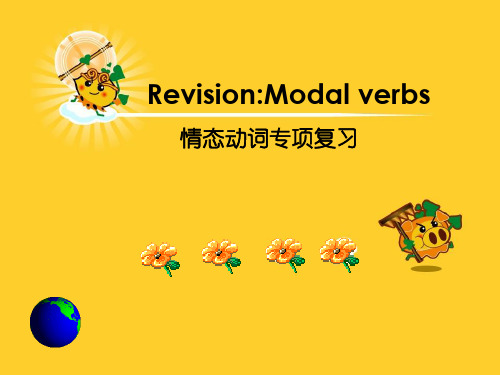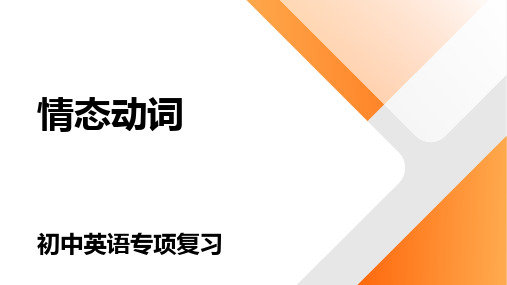初中情态动词讲解PPT课件
合集下载
情态动词(20张PPT)初中英语专项复习课件

看法。
(1)只作情态动词:must;can/could;may/might;ought to
(2)既可作情态动词又可作实义动词:need,dare
((34))既 具可 有作 情情 态态 动动词词某又些可特作征稿稿定助:定hPa动PPvTP,e词T/海h:量asd素ha材tlo持l;/s续hha更odublde;twteirll/would
【知识拓展】
1. must的一般疑问句,肯定回答为Yes, ...must.;否定回答为No, ...needn’t./No, ...don’t have
to.—Must I clean the classroom now? 我必须现在打扫教室吗?
—Yes, you must. 是的,你必须。/No, you don’t have to. /No, you needn’t. 不,你不必。
He promised he would never smoke again. 他承诺他再也不吸烟了。
Their English teacher would tell them stories in
表示过去反复发生的动 English after class.
作或某种倾向
他们的英语老师总是在课后用英语给他们讲故事
新,上千款模板选择总有一
款适合你
知识点二:情态动词的特点
情态动词的特点: (1)情态动词无人称和数的变化(have to除外); (2)情态动词后接动词原形; (3)情态动词的否定式是在其后加not; have to除外 (4)具有助动词的作用,可用来构成否定句、疑问句及用于简明答语; (5)个别情态动词有现在式和稿过定去PP式T两种形式,过去式用来表达更加客气、委 婉的语气,时态性不强,可稿用定于PPT过,海去量、素材现持在续更或将来。
(1)只作情态动词:must;can/could;may/might;ought to
(2)既可作情态动词又可作实义动词:need,dare
((34))既 具可 有作 情情 态态 动动词词某又些可特作征稿稿定助:定hPa动PPvTP,e词T/海h:量asd素ha材tlo持l;/s续hha更odublde;twteirll/would
【知识拓展】
1. must的一般疑问句,肯定回答为Yes, ...must.;否定回答为No, ...needn’t./No, ...don’t have
to.—Must I clean the classroom now? 我必须现在打扫教室吗?
—Yes, you must. 是的,你必须。/No, you don’t have to. /No, you needn’t. 不,你不必。
He promised he would never smoke again. 他承诺他再也不吸烟了。
Their English teacher would tell them stories in
表示过去反复发生的动 English after class.
作或某种倾向
他们的英语老师总是在课后用英语给他们讲故事
新,上千款模板选择总有一
款适合你
知识点二:情态动词的特点
情态动词的特点: (1)情态动词无人称和数的变化(have to除外); (2)情态动词后接动词原形; (3)情态动词的否定式是在其后加not; have to除外 (4)具有助动词的作用,可用来构成否定句、疑问句及用于简明答语; (5)个别情态动词有现在式和稿过定去PP式T两种形式,过去式用来表达更加客气、委 婉的语气,时态性不强,可稿用定于PPT过,海去量、素材现持在续更或将来。
情态动词语法讲解PPT课件

•You will wait outside the gate. •Brian! You will close the door.
b)表示“必然”,可用should,ought to和 must(一般用于陈述句),其中must口气最为 肯定。都指说话人根据一定情况做出推测或 判断.
•She should be here in a minute
•They must be home by now.(他们现在一定到家了)
will/would表示“推测”可有三种情况
1)对特定事态的推测
A: Who’s that man over there? B: That will be George, no doubt. C: That would be George, I except.
过去“能力”: could, was/were
able to
肯定句:
•Could:一般能力
• She could play the piano when she was only six.
• was/were able to(及managed to):具体 事件
• He was able to translate the article without a dictionary.
b)表示“可能”,可用may, might,
can, could
may/might:
1.既可以表示现在的可能,也可表示将来 的可能,might在口气上比may更委婉
• 现在:It may/might be true. • 将来:He may/might leave tomorrow.
2.在疑问句中,用can,不用may。
如果是推测过去的事态,则用must +have done
b)表示“必然”,可用should,ought to和 must(一般用于陈述句),其中must口气最为 肯定。都指说话人根据一定情况做出推测或 判断.
•She should be here in a minute
•They must be home by now.(他们现在一定到家了)
will/would表示“推测”可有三种情况
1)对特定事态的推测
A: Who’s that man over there? B: That will be George, no doubt. C: That would be George, I except.
过去“能力”: could, was/were
able to
肯定句:
•Could:一般能力
• She could play the piano when she was only six.
• was/were able to(及managed to):具体 事件
• He was able to translate the article without a dictionary.
b)表示“可能”,可用may, might,
can, could
may/might:
1.既可以表示现在的可能,也可表示将来 的可能,might在口气上比may更委婉
• 现在:It may/might be true. • 将来:He may/might leave tomorrow.
2.在疑问句中,用can,不用may。
如果是推测过去的事态,则用must +have done
《情态动词》PPT课件

work our this problem. 如果你睡个好觉,那么你就能做出这个题目。 3、表示过去的能力: could表示过去一般的能力, 但不表示做或未做某事;
was/ were able to表示过去有能力并且成功地做了某事, 相当于managed to do something/ succeeded in doing something;
• Mr. Bush is on time for everything. How can it be that he was late for the opening ceremony? (表疑惑、惊讶)
表示请求、允许、允诺
1. 当对方是决策者时,你代表你(们)自己(I, We),或代表第三者(he,she,they)向对方 (you)请示或提出建议时用:
Revision:Modal verbs
情态动词专项复习
How many modal verbs
do you remember?
(情态动词)
一,常见的情态动词有:can, could, may, might ,must, shall, should, will, would, need, have to等
4、具有情态动词的某些特征的有:have(had) to, used to.
情态动词的特征
1、有一定的词义,但不能单独作谓语,它们要和行 为动词或连系动词连用,构成谓语。
2、适用于主语的各种人称和数 have to例外,主语 是第三人称单数时,要用has to)。如:
We/ He must work hard. 我们/他一定要努力工作。 I have to walk home. 我得步行回家。 He has to walk home. 他得步行回家。
was/ were able to表示过去有能力并且成功地做了某事, 相当于managed to do something/ succeeded in doing something;
• Mr. Bush is on time for everything. How can it be that he was late for the opening ceremony? (表疑惑、惊讶)
表示请求、允许、允诺
1. 当对方是决策者时,你代表你(们)自己(I, We),或代表第三者(he,she,they)向对方 (you)请示或提出建议时用:
Revision:Modal verbs
情态动词专项复习
How many modal verbs
do you remember?
(情态动词)
一,常见的情态动词有:can, could, may, might ,must, shall, should, will, would, need, have to等
4、具有情态动词的某些特征的有:have(had) to, used to.
情态动词的特征
1、有一定的词义,但不能单独作谓语,它们要和行 为动词或连系动词连用,构成谓语。
2、适用于主语的各种人称和数 have to例外,主语 是第三人称单数时,要用has to)。如:
We/ He must work hard. 我们/他一定要努力工作。 I have to walk home. 我得步行回家。 He has to walk home. 他得步行回家。
情态动词(17张PPT)初中英语专项复习课件

情态动词表推测也是每年中考的重点,以考查can’t 和must为主,主要在单项选择中考查不同情态动词的辨 析。考生在解答此类试题时,可以从以下几方面着手: ①表示否定的推测:一是断然的否定,此类题一般是考 查情态动词表推测的用法,语境会对所填空给出解释, 据 此 可 以 判 断 是 非 常 肯 定 的 否 定 , 此 时 最 好 用 cannot /can’t;二是表示不能十分肯定或拿不准,此类题一般 也会有相关的语境提示,如I’m not sure、who knows等 ,此时最好用may或might。
表示需要、必须,主 要用于否定句和疑问 句中。needn’t常用 于回答must表请求的 否定回答
—Must I finish my homework now?我必 须现在完成我的家庭作 业吗? —No, you needn’t. 不, 你不需要。
注意 (1) must和have/has to均意为“必须”,常可互 换使用。但have/has to是用于强调客观需要,意为 “必须, 不得不”;must用于表示主观看法, 意为“ 必须, 应该”。如:We’ll have to ask Zhang Hong. 我们必须去问张红了。 We must work hard at school. 在学校我们必须 努力学习。
情态动词本身有一定的意义,但不能独立作谓语, 没有人称和数的变化,后面必须接动词原形。常见的情 态动词有:may, must, need, have to 等,具体用法见下表 :
情态动词
用法
例句
表示能力,意为 Sam can speak English well.
can “能,会”
山姆英语讲得很好。
He could have gone home. 他可能已回家了。
表示需要、必须,主 要用于否定句和疑问 句中。needn’t常用 于回答must表请求的 否定回答
—Must I finish my homework now?我必 须现在完成我的家庭作 业吗? —No, you needn’t. 不, 你不需要。
注意 (1) must和have/has to均意为“必须”,常可互 换使用。但have/has to是用于强调客观需要,意为 “必须, 不得不”;must用于表示主观看法, 意为“ 必须, 应该”。如:We’ll have to ask Zhang Hong. 我们必须去问张红了。 We must work hard at school. 在学校我们必须 努力学习。
情态动词本身有一定的意义,但不能独立作谓语, 没有人称和数的变化,后面必须接动词原形。常见的情 态动词有:may, must, need, have to 等,具体用法见下表 :
情态动词
用法
例句
表示能力,意为 Sam can speak English well.
can “能,会”
山姆英语讲得很好。
He could have gone home. 他可能已回家了。
情态动词-完整版PPT课件

情态动词 modal verbs
1.情态动词的用法特点
1)情态动词 除 ought 和 have 外,后面只能 接不带to 的不定式。 2)情态动词没有人称,数的变化,即情态动 词第三人称单数不加-s。 3)情态动词没有非谓语形式,即没有不定式, 分词等形式。
can could may might shall should must will would ought to
have to dare need used to
表示推测
情态动词
不表示推测
2.表示推测——情态动词的重要用法.
情态动词
对将来
对现在
对过去
m肯ust/定sho的uld 推测
+ V. + V. + have done
常见must be + be doi定的推测 can’t, couldn’t
疑问的推测
can, could
+ V.
+ V.
+ have done
+ be doing
可以用not表示“可能不”
+V.
+ V.
+ have done
+ be doing
+ V.
+ V.
+ have done
+ be doing
不同的“肯定”程度可按下列层次排列: He is at home. (事实) He must be at home.(非常肯定的推断) He ought to be at home.(很可能) He could be at home.(很可能) He may be at home.(仅仅可能而已) He might be at home.(或许, 非常不确定) He might not be at home.(也许不在家) He may not be at home. (比might可能) He couldn’t be at home.(很可能不在家) He can’t be at home.(一定不在家)
1.情态动词的用法特点
1)情态动词 除 ought 和 have 外,后面只能 接不带to 的不定式。 2)情态动词没有人称,数的变化,即情态动 词第三人称单数不加-s。 3)情态动词没有非谓语形式,即没有不定式, 分词等形式。
can could may might shall should must will would ought to
have to dare need used to
表示推测
情态动词
不表示推测
2.表示推测——情态动词的重要用法.
情态动词
对将来
对现在
对过去
m肯ust/定sho的uld 推测
+ V. + V. + have done
常见must be + be doi定的推测 can’t, couldn’t
疑问的推测
can, could
+ V.
+ V.
+ have done
+ be doing
可以用not表示“可能不”
+V.
+ V.
+ have done
+ be doing
+ V.
+ V.
+ have done
+ be doing
不同的“肯定”程度可按下列层次排列: He is at home. (事实) He must be at home.(非常肯定的推断) He ought to be at home.(很可能) He could be at home.(很可能) He may be at home.(仅仅可能而已) He might be at home.(或许, 非常不确定) He might not be at home.(也许不在家) He may not be at home. (比might可能) He couldn’t be at home.(很可能不在家) He can’t be at home.(一定不在家)
《情态动词讲解》课件

1
表示能力和可能性
这一用法涉及到情态动词在表示一个
表示推测和推断
2
人或事物的能力或可能性方面的应用。
情态动词还可用来表示具有推测性质
的情况和推断。
3
表示义务和建议
情态动词可用于表示某人应该或必须
表示意愿和打算
4
做的事情,或者提出建议。
用情态动词来表达某人的意愿或打算 进行的行为。
情态动词的否定和疑问
3 同时使用情态动词和实义动词时的注意事项
了解使用情态动词和实义动词时需要注意的细节。
总结
情态动词的重要性
深入理解情态动词的重要性,以及它们在语言中 的作用。
情态动词的学习方法
提供一些有效的学习方法,帮助您更好地掌握情 态动词的用法。
参考资料
书籍推荐
推荐一些深入学习情态动词的相关书籍。
网站推荐
建议一些在线资源,以便进一步学习和练习 情态动词。
2 may/might
表示推测和推断的情态 动词。
3 shall/should
表示义务和建议的情态 动词。
4 will/would
表示意愿和打算的情态动词。
5 must
表示必须和必然的情态动词。
情态动词的用法
情态动词有多种用法,我们将详细讨论其中的一些,包括表示能力和可能性、推测和推断、义务和建 议,以及意愿和打算。
特点
情态动词具有几个典型的特点,例如它们没有人称和数的变化,并且后面跟原形动词。
情态动词的种类
情态动词有几种常见的类型,我们将深入讨论其中的几个种类,包括can/could、may/might、 shall/should、will/would以及must。
1 can/could
情态动词精品课件PPT课件

第22页/共52页
• It is usually warm in my hometown in March,but it can be rather cold sometimes.
• 我的家乡在三月份通常很暖和,但有时候也会相当冷。 • Mr.Bush is on time for ever ything.How can it be that he was late for the
meeting? • 布什先生做什么事情都很准时,他怎么可能开会迟到呢? • He can't be in the classroom ,for the light has been turned off. • 他一定不在教室里,因为灯已关了。
第23页/共52页
• 2.may用于肯定句中可以用来表示推测,意为“可能”;用于否定句中也可以表示 推测,may not意为“可能不”,表示一种不太确定的语气。may在疑问句中一般不 表示推测。
You'd better not. 等)不,你不可以用。
第11页/共52页
• 3.must和have to的用法 • must表示“必须、应该”。否定形式must not(mustn't)表示“不应该、不许可、
不准、禁止”等。在回答must的问句时,否定式常用need not(needn't)或don't have to表示“不必”,而不用must not,因为must not表示“禁止”。must表 示“一定、必定”等推测意义时,一般只用在肯定句中。 • The work must be finished as soon as possible. • 这项工作必须尽快完工。
第21页/共52页
• 热点考向二 情态动词表“推测”的用法 • 表示对目前或将来情况的推测往往用“情态动词+动词原形”这种结构。 • 1.can用于肯定句中表示可能性,意为“有时会”;用于疑问句中可以表示推测,意
• It is usually warm in my hometown in March,but it can be rather cold sometimes.
• 我的家乡在三月份通常很暖和,但有时候也会相当冷。 • Mr.Bush is on time for ever ything.How can it be that he was late for the
meeting? • 布什先生做什么事情都很准时,他怎么可能开会迟到呢? • He can't be in the classroom ,for the light has been turned off. • 他一定不在教室里,因为灯已关了。
第23页/共52页
• 2.may用于肯定句中可以用来表示推测,意为“可能”;用于否定句中也可以表示 推测,may not意为“可能不”,表示一种不太确定的语气。may在疑问句中一般不 表示推测。
You'd better not. 等)不,你不可以用。
第11页/共52页
• 3.must和have to的用法 • must表示“必须、应该”。否定形式must not(mustn't)表示“不应该、不许可、
不准、禁止”等。在回答must的问句时,否定式常用need not(needn't)或don't have to表示“不必”,而不用must not,因为must not表示“禁止”。must表 示“一定、必定”等推测意义时,一般只用在肯定句中。 • The work must be finished as soon as possible. • 这项工作必须尽快完工。
第21页/共52页
• 热点考向二 情态动词表“推测”的用法 • 表示对目前或将来情况的推测往往用“情态动词+动词原形”这种结构。 • 1.can用于肯定句中表示可能性,意为“有时会”;用于疑问句中可以表示推测,意
七年级英语 动词(1)情态动词课件

句型转换 She can play the guitar.(变成一般疑问句) ______ she_____ the guitar?
句型转换 She can play the guitar.(变成一般疑问句) ______ she_____ the guitar? 答案:Can play 解析:含情态动词can的陈述句,变一般疑问句,直接将can提到句首。 考点:情态动词can的用法
You ______ go and see a doctor at once because you look so weak. A.can B.may C.must D.will
You ______ go and see a doctor at once because you look so weak. A.can B.may C.must D.will 答案:C 解析:根据句意,此处must表示“必须”较为恰当。 考点:情态动词
【知识精讲】情态动词
初一 英语
概念:情态动词是一种本身有一定的词义,表示说话人的 情绪、态度或语气的动词,但不能单独作谓语,只能和其 他动词原形构成复合谓语,没有人称和数的变化。 情态动词数量不多,但用途广泛,主要有: can (could), may , must等。
I can speak English/Chinese. Can you speak English/Chinese? Yes,I can./we can. No,I can't/we can't.
Does he have to do it? Yes, he does. No, he doesn't. Must he do it? Yes, he must don't have to go there. You mustn't go there.
情态动词(12张PPT)初中英语专项复习课件

例句
可能性
The storybook could be Jim’s. He likes reading
小
could 很可能 stories.这本故事书很可能是吉姆的,他喜欢读故
事。
This book must be Lucy’s, for her name is on the must 一定 cover.这本书一定是露西的,因为封面上有她的名 大
态 动
had better 最好,用来提出建议
today.
词
情态动词的基本含义
分析近三年中考真题可知,情态动词的基本用法是中考必考点,考生需 掌握各个情态动词的基本含义(见"考点帮")。
在答题时,应注意结合语境,并考虑常见句型。 常考情态动词有can、may和must及情态动词的否定形式needn’t、
基 本 句
②可能,也许,表示推
They might laugh at me.
型
might 测
情
态 动 词
常 见 情
①必须,表示命令或主观 看法
—Must I finish the homework today? —No, you needn’t/don’t have to. He must be staying here.
基
①能,会,表示能力
I can sing.
本
②可能,表示推测,常用于否定句和疑 Can it be right?
句
问句
型
can ③可以,表示许可和征求对方意见
Can you help me?
情
①能,会,can的过去式,表 I could do it.
态
常
过去的能力
初中情态动词讲解ppt课件

气。 • I want to ask you a question. • =I'd(I would)like to ask you a question. • 我想问你一个问题。 • 3.Would you like~? • 表示请求、劝说,是很客气的说法。 • Would you like a cup of tea? • 您愿意喝杯茶吗?
• b.可能、或许 • (谈论可能性、表示推测,一般用于肯定句)
• Tomorrow I may go shopping. • 明天,我可能(或许)去商店买东西。 • He might be our new teacher. • 他或许是我们的新老师。 • 注意 • might在表示推测时,不表示时态,只是说明可能性比may还要小。
4
must
• a.必须、应该(表示有做某一动作的必要或义务)
• You must buy a ticket. • 你必须买一张票。 • b.一定、准是(表示有把握的判断或推测,一般只用于肯定句中)
• 在You must~.这一句型中,它的意思与祈使句相同。 • You must get up early. =Get up early. • 你必须早起。 • You must study hard. =Study hard. • 你必须用功读书。 • He must be our new teacher. • 他肯定是我们的新老师。 • (语气比may,might要肯定得多)
9
should
• should的用法 • You should read this book. • 你应该读这本书。
• 1.should(应当、应该)用于所有人称,与 ought to~同义。
• You should wait a little more. • =You ought to wait a little more. • 你应该再多等一会儿。
• b.可能、或许 • (谈论可能性、表示推测,一般用于肯定句)
• Tomorrow I may go shopping. • 明天,我可能(或许)去商店买东西。 • He might be our new teacher. • 他或许是我们的新老师。 • 注意 • might在表示推测时,不表示时态,只是说明可能性比may还要小。
4
must
• a.必须、应该(表示有做某一动作的必要或义务)
• You must buy a ticket. • 你必须买一张票。 • b.一定、准是(表示有把握的判断或推测,一般只用于肯定句中)
• 在You must~.这一句型中,它的意思与祈使句相同。 • You must get up early. =Get up early. • 你必须早起。 • You must study hard. =Study hard. • 你必须用功读书。 • He must be our new teacher. • 他肯定是我们的新老师。 • (语气比may,might要肯定得多)
9
should
• should的用法 • You should read this book. • 你应该读这本书。
• 1.should(应当、应该)用于所有人称,与 ought to~同义。
• You should wait a little more. • =You ought to wait a little more. • 你应该再多等一会儿。
初中英语-情态动词-课件(共31张PPT)

二、情态动词的用法 4.dare和need
need “需要” dare“敢” 可作情态动词也可作实义动词
• (2)当实义动词使用时,有人称和时态的变化 • e.g.You don't need to do it yourself. • He did not dare(to) look up.
• ——Can you drive a car at present? • ——I_____ do so in the busy street.
• A.may not C.daren't
B.don't dare D.needn't
二、情态动词的用法 ed to和had better
• (1)used to表示过去的习惯动作或状态,现 已不存在。
• e.g.There used to be our playground.
二、情态动词的用法 ed to和had better
time. • I'll not be able to come this afternoon.
二、情态动词的用法
• (2)表客观可能性,在疑问句中表示请求或许可 • e.g.Man can not live without air. • Can I use your pen?
• *could是can的过去时,主要用于疑问句,表示语气委婉。 • 肯定回答用 • 否定回答可用
C.should tell
D.should have told
二、情态动词的用法 7.will和would
(1)表意愿,用于各种人称的陈述句。
• e.g.I will do anything for you. • If you will read the book,I'll lend it to you.
情态动词 专题课件(共28张PPT)

➢ 5. (may/can) ____c_a_n_____you swim? 表示能力
➢ 6. Listen, please. You (may not/might not)
____m__a_y__n_o_t______ speak during this exam.
表示不允许
may, might, can, could
may, might, can, could
表示猜测
➢ 1. They (can/might) ____m_i_g_h_t___be away for the
weekend but I’m not sure.
表示许可
➢ 2. You (may/might) ___m__a_y____leave now if you
can and could
➢So he can carry heavy books. ➢ability ➢He couldn't open the door by himself. ➢ability ➢Could you open the door, please? ➢request
can and could
表示猜测(不可能)
➢7. They (can not/may not) ___c_a_n_n_o_t_______ still be out, the light is on in the house.
➢8. You (couldn’t/might not) 表示许可
____c_o_u_ld_n_’_t_______ smoke on the bus.
➢9. With luck, tomorrow (can/could) ___c_o_u_ld____be a cooler day. 表示猜测
- 1、下载文档前请自行甄别文档内容的完整性,平台不提供额外的编辑、内容补充、找答案等附加服务。
- 2、"仅部分预览"的文档,不可在线预览部分如存在完整性等问题,可反馈申请退款(可完整预览的文档不适用该条件!)。
- 3、如文档侵犯您的权益,请联系客服反馈,我们会尽快为您处理(人工客服工作时间:9:00-18:30)。
may 也表示猜测,意为“可能”。
3) Where is my English book? It might / may be in your desk.
Ⅰ.用适当的情态动词填空:
1. I can play football. ____C__a_n___you swim? 2. I can’t play with you. I ___m_u__s_t___finish my
must / must not
以must开头的疑问句,
肯定回答:Yes , …must.
否定回答: No, … needn’t. 或 No, … don’t have to.
-- Must I clean the classroom now? -- Yes, you___m_u_s_t_ . -- No, you __n_e_e_d_n_’t__ . /
9. __D____ the girl read before she went to school? A. Can B. Must C. Can D. Could
He is a singer and actor, he is known by everyone.
6. _C__o_u_l_d____you please tell me where the
station is ?
7. Must I finish the work now ?
No, you __n_e_e_d__n_’t___.
8. --Need I take this book out? --Yes , you __D___ . A. can B. may C. need D. must
must 的用法:
must 必须 ,表示说话Байду номын сангаас的 主观意志。 You must do your homework first.
must / must not
must not的用法: mustn’t 表示禁止 ,不准,不允许。 You mustn’t smoke here.
You mustn’t play with fire.
need 作行为动词,有人称、数和时态的 变化后接to do, 即 need to do sth.
might / may
might 1. 是 may 的过去式。
2. 表示推测, 可能性较小。 1) He might be very busy now. 2) Your mother might know the truth.
3) Can you skate? 2. 表示允许 (可以)
1)Can I use your dictionary? 2)----- Can I go home now?
----- Yes, you can. / No, you can’t.
could
1. 是can 的过去式; 表示过去的能力;
He could ride a bike at the age of five.
一起构成谓语动词。 4. 一般疑问句提前边,
否定句在后直接加 not.
3 情态动词如何使用呢?
can / can not
1. 表示能力 (会)
1) Mary can speak English, but she can not speak
French.
2) Can you lift this heavy box?
homework first.
3. I___m__u_s_t___ get up early tomorrow. because I
have a meeting.
4. Nobody ___c_a__n_____live without air.
5.__M__a_y_____I come in ?Yes ,please.
2. 用于婉转语气,多用于问句。“能,可以” Could you please clean the room?
---- Could I come to see you tomorrow? ---- Yes, you can. ( No, you can’t. )
此处 could 不是过去式,只是语气更委婉, 答语中不能用could和 couldn’t,要用can 和
Learning goals:
1 复习部分情态动词的用法 2 情态动词的新用法—情态动词表示推测 3 对物品的归属进行猜测
➢ 思考?
1 你记得学过哪些主要的情态动词吗?
can. could, may, must,might, have to…
2 情态动词有哪些语法特征呢?
1. 情态动词有具体的词义。 2. 情态动词没有人称和数的变化。 3. 情态动词后必须跟动词原形,两者
No, you __d_o_n_’_t_h_a_v_e_to_ .
need
need作情态动词,主要用于疑问句和否定句中
need 一般疑问句: 肯定回答用 Yes, … must, 否定回答用 No,…needn’t . 或 No,…don’t have to.
如: Need I do it now? Yes, you __m_u_s_t___。 No, you _n_e_e_d_n_’t_/_d_o_n_’_t _h_a_ve__to__ .
2. --May I use your washroom now?
--No, you ___B___. There’s something wrong with the
toilet.
A. needn’t B. mustn’t C. shouldn’t D. didn’t
must / must not
can’t。
may / may not
may的用法: 1. 表示请求和允许 (可以), 比can 正式.
May I come in? He may come if he likes.
may / may not
may的一般疑问句,其否定回答用 can’t 或
mustn’t。
1. --May I go home now? --Yes, you may. / Sure. / Yes, please. No, you can’t./ mustn’t.
3) Where is my English book? It might / may be in your desk.
Ⅰ.用适当的情态动词填空:
1. I can play football. ____C__a_n___you swim? 2. I can’t play with you. I ___m_u__s_t___finish my
must / must not
以must开头的疑问句,
肯定回答:Yes , …must.
否定回答: No, … needn’t. 或 No, … don’t have to.
-- Must I clean the classroom now? -- Yes, you___m_u_s_t_ . -- No, you __n_e_e_d_n_’t__ . /
9. __D____ the girl read before she went to school? A. Can B. Must C. Can D. Could
He is a singer and actor, he is known by everyone.
6. _C__o_u_l_d____you please tell me where the
station is ?
7. Must I finish the work now ?
No, you __n_e_e_d__n_’t___.
8. --Need I take this book out? --Yes , you __D___ . A. can B. may C. need D. must
must 的用法:
must 必须 ,表示说话Байду номын сангаас的 主观意志。 You must do your homework first.
must / must not
must not的用法: mustn’t 表示禁止 ,不准,不允许。 You mustn’t smoke here.
You mustn’t play with fire.
need 作行为动词,有人称、数和时态的 变化后接to do, 即 need to do sth.
might / may
might 1. 是 may 的过去式。
2. 表示推测, 可能性较小。 1) He might be very busy now. 2) Your mother might know the truth.
3) Can you skate? 2. 表示允许 (可以)
1)Can I use your dictionary? 2)----- Can I go home now?
----- Yes, you can. / No, you can’t.
could
1. 是can 的过去式; 表示过去的能力;
He could ride a bike at the age of five.
一起构成谓语动词。 4. 一般疑问句提前边,
否定句在后直接加 not.
3 情态动词如何使用呢?
can / can not
1. 表示能力 (会)
1) Mary can speak English, but she can not speak
French.
2) Can you lift this heavy box?
homework first.
3. I___m__u_s_t___ get up early tomorrow. because I
have a meeting.
4. Nobody ___c_a__n_____live without air.
5.__M__a_y_____I come in ?Yes ,please.
2. 用于婉转语气,多用于问句。“能,可以” Could you please clean the room?
---- Could I come to see you tomorrow? ---- Yes, you can. ( No, you can’t. )
此处 could 不是过去式,只是语气更委婉, 答语中不能用could和 couldn’t,要用can 和
Learning goals:
1 复习部分情态动词的用法 2 情态动词的新用法—情态动词表示推测 3 对物品的归属进行猜测
➢ 思考?
1 你记得学过哪些主要的情态动词吗?
can. could, may, must,might, have to…
2 情态动词有哪些语法特征呢?
1. 情态动词有具体的词义。 2. 情态动词没有人称和数的变化。 3. 情态动词后必须跟动词原形,两者
No, you __d_o_n_’_t_h_a_v_e_to_ .
need
need作情态动词,主要用于疑问句和否定句中
need 一般疑问句: 肯定回答用 Yes, … must, 否定回答用 No,…needn’t . 或 No,…don’t have to.
如: Need I do it now? Yes, you __m_u_s_t___。 No, you _n_e_e_d_n_’t_/_d_o_n_’_t _h_a_ve__to__ .
2. --May I use your washroom now?
--No, you ___B___. There’s something wrong with the
toilet.
A. needn’t B. mustn’t C. shouldn’t D. didn’t
must / must not
can’t。
may / may not
may的用法: 1. 表示请求和允许 (可以), 比can 正式.
May I come in? He may come if he likes.
may / may not
may的一般疑问句,其否定回答用 can’t 或
mustn’t。
1. --May I go home now? --Yes, you may. / Sure. / Yes, please. No, you can’t./ mustn’t.
